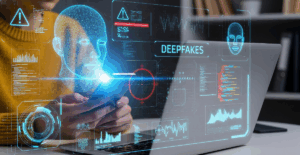
Artificial Intelligence (AI) is making waves in the digital world, and AI-driven cybercrime is transforming the digital threat landscape. From predictive analytics that help us forecast future trends to automation that simplifies complex business processes, AI has become a core driver of innovation and efficiency. Yet the same technology that enables progress is also being weaponised by cybercriminals, — turning intelligence into exploitation and automation into attack.
The rise of AI-driven cybercrime is redefining what it means to stay secure in a hyperconnected world. The tools designed to improve productivity and decision-making are being repurposed to deceive, manipulate, and exploit individuals. This dual use of AI — innovation versus imitation — has created a new cybersecurity frontier where trust itself is under threat.
AI-Driven Cybercrime: When Innovation Meets Exploitation
AI has significantly lowered the technical barriers to entry for cybercriminals. What once required advanced coding expertise or insider knowledge can now be achieved with automated tools and generative AI systems. In late 2024 alone, AI-powered phishing increased by more than 200%<, with most phishing emails now containing AI-generated content — and the majority of recipients still opening them.
These attacks are not just technical; they’re psychological too. AI can convincingly replicate writing styles, speech patterns, and even facial expressions. Deepfake technology enables attackers to impersonate trusted individuals with accuracy. In one high-profile 2024 incident, a finance employee authorised a $25 million transfer after joining a video call that featured deepfake versions of company executives.
This has serious implications as cybercriminals are no longer focused solely on breaching systems but targeting human perception too. When AI can mimic a familiar face or voice, it becomes increasingly difficult for even trained professionals to distinguish what’s real from what’s fake.
The Expanding Human Attack Surface
As AI becomes more sophisticated, the human element remains the most vulnerable point in any organisation’s defences. Employees increasingly rely on AI tools for everyday tasks, from drafting documents to analysing data, but this convenience introduces new risks.
Research shows that employee use of generative AI can inadvertently expose sensitive information, especially when staff share confidential or proprietary data with external AI platforms. At the same time, the overall number of cyberattacks continues to rise, with global weekly attacks per organisation increasing by more than 50% in the last two years alone.
This widening gap between technological protection and human readiness poses a serious challenge. Firewalls and detection systems can’t prevent an employee from trusting a realistic-sounding voice, clicking a well-crafted phishing link, or entering data into a malicious chatbot. The battlefield has shifted from defending networks to protecting human behaviour.
Every employee interaction, message, and click represents a potential entry point for attackers meaning the new frontline of cybersecurity is the individual user.
From Awareness to Action: The Role of Human Risk Management in Overcoming AI attacks
While awareness education has long been a key part of cybersecurity strategies, it’s no longer enough on its own to protect today’s businesses. AI-driven attacks evolve too quickly, and the methods of deception are too subtle for static, once-a-year education to keep pace.
Human Risk Management (HRM) is the next step. It focuses on changing behaviours through continuous learning, real-time feedback, and measurable improvement. Rather than just telling employees what not to do, HRM provides insight into how people interact with technology for them to see where vulnerabilities exist to be able and act on those vulnerability.
This proactive approach enables organisations to deliver targeted interventions, reinforce positive security habits, and measure progress over time. It’s about embedding security awareness into everyday routines, not just once a year compulsory learning, and empowering employees to pause, question, and check before acting.
By shifting from awareness to action, organisations can reduce risk at the source — the human layer — and create a workforce that is alert, informed, and resilient in the face of AI-enabled manipulation.
The Path Forward to Defend Against AI-Driven Cybercrime
AI-driven cybercrime is both a challenge and an opportunity. It highlights how the future of cybersecurity depends as much on human judgement as technical innovation. As cyber threats evolve, so must our defences, both through advanced technologies and empowered, security-conscious individuals.
By embracing Human Risk Management and fostering a culture where employees take ownership of cybersecurity, organisations can transform their people from the weakest link into their strongest defence.
In an era where even reality can be fabricated, human intuition and awareness remain the most reliable safeguards. True resilience depends not just on smarter systems, but on smarter decisions made by informed employees.
Now is the time to act. As AI-powered threats become more prevalent, organisations must equip their workforce with the knowledge, habits, and confidence to recognise and resist attacks.
Strengthen your human firewall and protect your business by adopting a Human Risk Management platform that empowers employees to stay one step ahead of AI-driven cybercrime.
AI-Driven Cybercrime FAQs: Protect Your Human Firewall
What is AI-driven cybercrime?
AI-driven cybercrime uses artificial intelligence to automate attacks, create realistic phishing, or impersonate trusted individuals.
Why is AI-driven cybercrime a growing threat?
AI makes attacks faster, more convincing, and harder to detect, targeting both systems and human behaviour.
How can employees recognise AI-driven cyber threats?
Look for unusual messages, unexpected requests, deepfake calls or videos, and links or attachments that seem out of context.
What role does Human Risk Management (HRM) play in prevention?
Human Risk Management (HRM) empowers employees to recognise threats, build secure habits, and reduce risk at the human layer before attacks succeed.